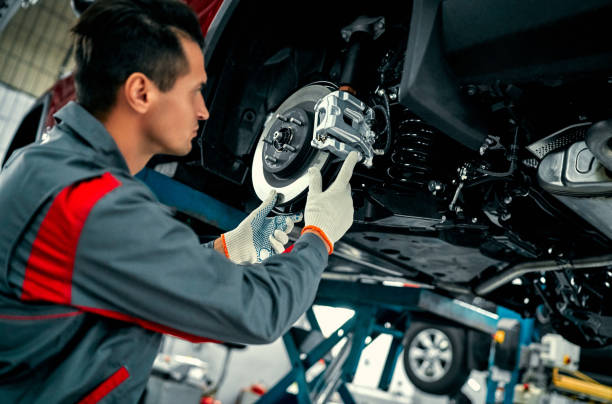Bought Aftermarket Rims? Don’t Forget These Fitting Parts
 Part Eazy
Part Eazy
Upgrading your car with a fresh set of aftermarket rims can completely change its look and feel—giving it a sportier edge, more aggressive stance, or simply a custom flair that stands out. But while choosing the perfect set of rims is exciting, it’s only part of the job. Fitting them correctly requires more than just swapping out the old ones. There are crucial supporting components you need to install for a proper fit, smooth ride, and long-term safety.
If you've recently taken the plunge and ordered new wheels, here’s what you shouldn’t overlook when completing your upgrade.
Why Aftermarket Rims Need Extra Fitting Parts
Factory wheels are designed with your vehicle’s exact specifications in mind—aftermarket rims, however, come with more universal sizing. This means that although they may look fantastic, they often require some tweaks to match your car’s specs perfectly. Failing to do this can lead to issues like vibrations, uneven tire wear, or even potential safety risks.
So before you hit the road, make sure you’ve checked off all the essential fitting parts to go along with your new rims.
Must-Have Components for Proper Rim Fitment
Here are the key parts you should consider when installing aftermarket rims:
1. Hub Centric Rings
These small rings ensure your new rims sit perfectly centered on the hub. Most aftermarket wheels are designed with a larger center bore to fit multiple vehicles. Without these rings, you may experience steering wheel vibrations.
2. Wheel Lug Nuts or Bolts
Factory lug nuts might not always be compatible with aftermarket wheels. You’ll need to double-check the seat type (conical, ball, or flat) and thread size. Investing in the correct lug nuts ensures a safe and tight fit.
3. Wheel Spacers
If your new rims sit too close to the suspension or inner wheel arch, spacers help adjust the offset. They push the wheel outward slightly, allowing for better clearance and a more aggressive stance.
4. TPMS Sensors
Don’t forget about your Tire Pressure Monitoring System. Some aftermarket wheels won’t support your factory sensors, so you may need to purchase compatible ones or new sensor bands.
5. Center Caps
Some wheels don’t come with center caps or may not be compatible with your original ones. Center caps help keep dirt away from the hub and give the wheels a clean, finished look.
Pro Tip: Don’t Just Shop for Rims – Shop Smart
Finding the right components doesn’t need to be complicated. Many trusted car parts sites offer complete fitment kits and professional advice tailored to your vehicle make and model. Whether you’re upgrading performance or just improving style, having access to the right guidance ensures every part fits exactly how it should.
And while you’re at it, don’t forget to brush up on your knowledge of wheel offset—understanding this measurement can help you pick rims that not only fit well but enhance handling and visual appeal too.
Things to Check Before Final Fitment
Before securing those shiny new wheels, take a moment to go through this pre-install checklist:
Double-check bolt pattern – Does your wheel’s bolt pattern match your vehicle?
Confirm offset compatibility – Will your rims clear the suspension and brake components?
Inspect tire size – Is the tire width and sidewall height suitable for your new wheels?
Balance and alignment – Have your wheels professionally balanced, and get a wheel alignment after installation.
Test drive after installation – Listen and feel for any vibrations, pulling, or abnormal sounds.

Frequently Asked Questions (FAQs)
Q1: Can I install aftermarket rims without hub centric rings? You can, but it’s not recommended. Without hub centric rings, your wheels rely solely on the lug nuts for centering, which can lead to vibrations and stress on wheel components.
Q2: How do I know if I need wheel spacers? If your aftermarket wheels touch suspension components or don’t give your vehicle the stance you want, spacers are likely needed. Measure your current offset against your wheel’s specs to find the right thickness.
Q3: Will aftermarket rims affect my car’s ride quality? They can, depending on their size, weight, and design. Heavier or larger wheels may slightly reduce ride comfort but can also improve handling. Always opt for wheels compatible with your car’s suspension setup.
Q4: Can I use my stock lug nuts with aftermarket wheels? Not always. Many aftermarket wheels require specific lug nuts that match their seat type. Using the wrong kind may damage the wheels or compromise safety.
Q5: Are TPMS sensors required by law? In many regions, yes. If your vehicle originally came with TPMS, it’s best to retain or replace them when installing new wheels to avoid warning lights and maintain safety.
Beyond Rims: Complete Your Custom Look
Your wheels might be the highlight, but for a truly cohesive upgrade, consider matching other parts as well—like grilles, bumpers, or side skirts. Quality body parts for cars can enhance both aesthetics and aerodynamics, tying your entire vehicle’s look together with style and functionality.
At PartEazy, we know that performance meets precision when the right parts come together. PartEazy is your go-to destination for premium car and truck parts and accessories. Whether you're a DIY enthusiast, a professional mechanic, a performance upgrader, or simply looking for an affordable fix, we offer high-quality products and exceptional service to keep your vehicle running at its best.
Roll in Style, Drive with Confidence
Don't let your rim upgrade stop at good looks. With the right parts and a bit of planning, your ride will not only turn heads—but stay strong, safe, and smooth on every journey.
Explore more. Upgrade smarter. Drive better—with PartEazy.
Subscribe to my newsletter
Read articles from Part Eazy directly inside your inbox. Subscribe to the newsletter, and don't miss out.
Written by

Part Eazy
Part Eazy
Be ready before trouble hits. PartEazy helps you find and order essential car parts online—fast, easy, and reliable for any emergency or upgrade.